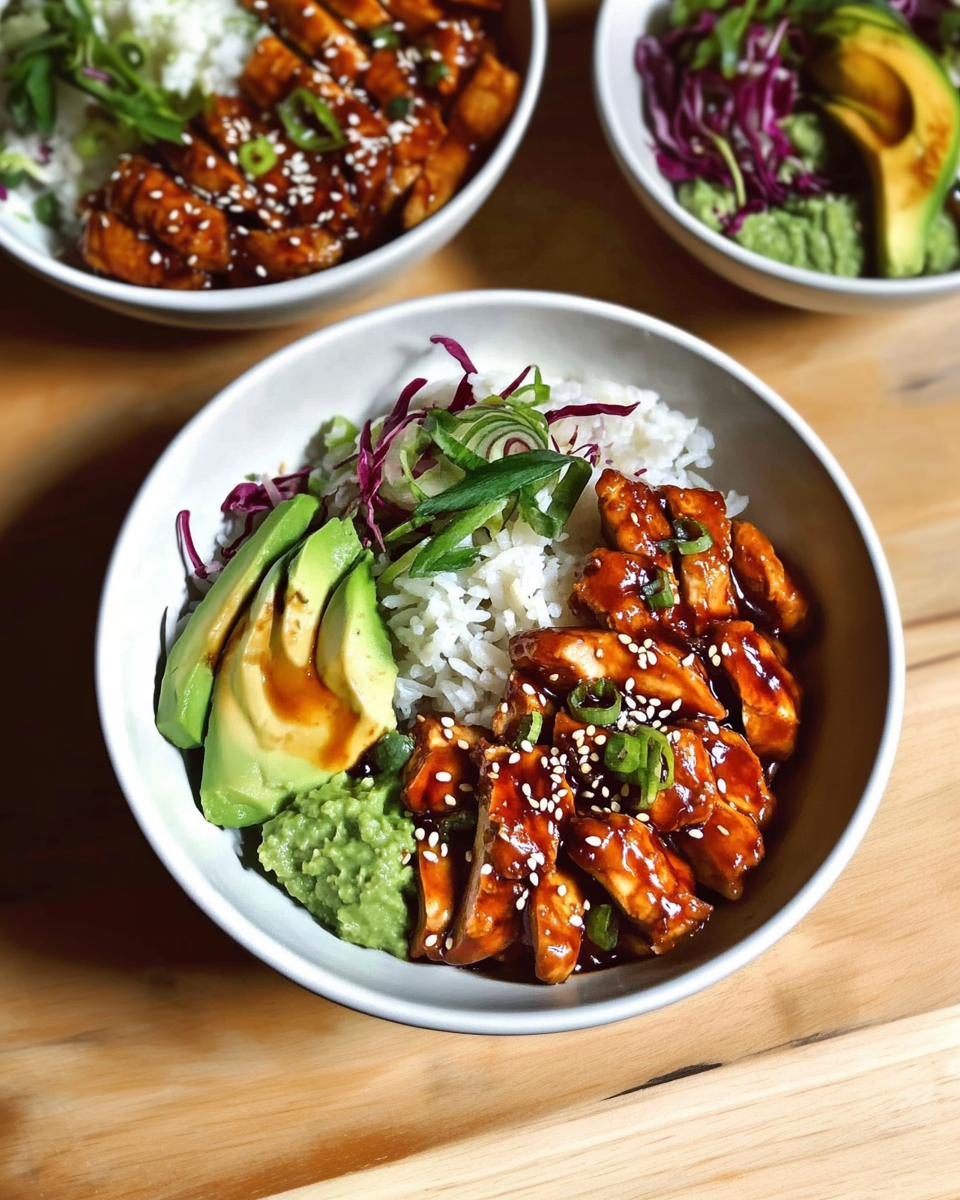The Japanese Teriyaki Chicken Bowl is a delightful fusion of flavors and textures, offering a harmonious blend of tender chicken glazed in a savory-sweet teriyaki sauce, complemented by a refreshing Asian-inspired coleslaw, creamy avocado slices, and a bed of hot rice. This dish is not only delicious but also versatile, making it perfect for busy weeknights, meal prepping, or satisfying takeout cravings. Its balance of protein, vegetables, and healthy fats ensures a nutritious and satisfying meal in one bowl.
Full Recipe:
Ingredients
- 4–5 boneless skinless chicken thighs or 2 boneless skinless chicken breasts
- 1 cup short-grain rice
- 1 avocado
- 2 tablespoons cooking oil
For Teriyaki Sauce:
- ½ cup soy sauce
- 2 tablespoons rice vinegar or white vinegar
- ¼ cup brown sugar
- 1 tablespoon honey
- 1 tablespoon sesame oil
- 1 tablespoon garlic, finely chopped
- 1 tablespoon ginger, finely chopped
- ½ teaspoon red chili flakes (optional)
- 2 teaspoons cornstarch
- ¼ cup water
For Asian Coleslaw:
- 1 carrot or 8–10 baby carrots, cut into thin matchsticks
- 1 small cucumber, thin matchsticks
- 2 cups red cabbage, julienned
- 2–3 sprigs cilantro
- 2 green onions
Dressing:
- ¼ cup apple cider vinegar
- 1½ tablespoons sugar
- 1 tablespoon sesame oil
- 1½ tablespoons sesame seeds
- Kosher salt, to taste
- Pepper, to taste
Directions
- Prepare Teriyaki Sauce: In a saucepan, combine soy sauce, rice vinegar, brown sugar, honey, sesame oil, garlic, ginger, and red chili flakes (if using). Bring to a simmer over medium heat, stirring continuously until the sugar dissolves. Lower the heat and let it simmer for 5 minutes. In a small bowl, mix cornstarch with water to create a slurry. Slowly add this mixture to the saucepan, stirring constantly until the sauce thickens. Remove from heat and let it cool.
- Marinate Chicken: Place the chicken thighs or breasts in a shallow dish and pour a quarter of the teriyaki sauce over them. Ensure the chicken is well-coated, cover, and refrigerate for at least 30 minutes to marinate.
- Cook Rice: While the chicken marinates, cook the short-grain rice according to the package instructions. Once cooked, set aside and keep warm.
- Prepare Coleslaw: In a large bowl, combine the carrot, cucumber, red cabbage, cilantro, and green onions. In a separate small bowl, whisk together the apple cider vinegar, sugar, sesame oil, sesame seeds, salt, and pepper. Pour the dressing over the coleslaw mixture and toss until well combined. Refrigerate until ready to serve.
- Cook Chicken: Heat the cooking oil in a skillet over medium-high heat. Remove the chicken from the marinade (discarding any leftover marinade) and cook the chicken for 3–4 minutes per side until golden brown and cooked through, with an internal temperature of 165°F (74°C). During the last minute of cooking, pour the remaining teriyaki sauce over the chicken, allowing it to glaze the meat. Remove from heat and let the chicken rest for a few minutes before slicing it into strips.
- Assemble Bowls: To assemble, place a serving of rice at the bottom of each bowl. Arrange slices of teriyaki chicken on top of the rice. Add a generous portion of the prepared coleslaw beside the chicken. Place avocado slices on the other side. Garnish with additional sesame seeds and serve immediately.
Nutritional Facts (Per Serving)
- Calories: 655 kcal
- Total Fat: 34g
- Saturated Fat: 6g
- Trans Fat: 0g
- Unsaturated Fat: 27g
- Cholesterol: 171mg
- Sodium: 2205mg
- Carbohydrates: 51g
- Fiber: 8g
- Sugars: 26g
- Protein: 41g
Cultural Significance and Origins
Teriyaki as a cooking technique and flavor profile is a cornerstone of Japanese cuisine. The word “teriyaki” comes from “teri,” meaning glaze or shine, and “yaki,” meaning to grill or broil. Traditionally, teriyaki involves grilling or broiling foods with a glaze made from soy sauce, mirin (sweet rice wine), and sugar, creating a beautiful shiny coating. While the technique dates back centuries in Japan, it has evolved and gained global popularity, especially in Western countries, where variations using different proteins and serving styles have become common.
The Japanese Teriyaki Chicken Bowl is a modern take on this classic. It encapsulates not only the rich flavors of teriyaki chicken but also incorporates fresh, crisp vegetables and creamy avocado, which adds a contemporary twist and nutritional balance. This dish serves as a fantastic introduction to Japanese flavors for many who may be new to the cuisine.
Flavor Profile and Texture
One of the key reasons the Japanese Teriyaki Chicken Bowl is so beloved is its layered and harmonious flavor profile. The teriyaki sauce offers a luscious balance of salty, sweet, and umami tastes, which beautifully coat the chicken. The slight caramelization on the grilled chicken adds a smoky depth and a tender, juicy bite.
The inclusion of the Asian coleslaw introduces a refreshing contrast. Crisp carrots, crunchy cabbage, and cool cucumber dressed in a tangy, slightly sweet vinaigrette provide a light and vibrant counterpoint to the rich chicken. Meanwhile, the creamy avocado slices add a buttery smoothness and subtle richness that enhances the overall mouthfeel.
Finally, the soft, fluffy short-grain rice serves as the comforting base that absorbs all the flavors and juices, tying the whole bowl together. This interplay of textures—crisp vegetables, tender chicken, creamy avocado, and fluffy rice—makes each bite satisfying and exciting.
Nutritional Benefits
This dish is not only flavorful but also packs a variety of nutrients that support a balanced diet. Chicken is an excellent source of lean protein, vital for muscle repair and overall bodily function. The cooking method keeps the chicken tender without excessive added fats, maintaining a health-conscious approach.
The fresh vegetables in the Asian coleslaw contribute dietary fiber, vitamins, and antioxidants. Fiber promotes digestive health and helps maintain a feeling of fullness, while vitamins like vitamin C and vitamin K support immune function and bone health respectively.
Avocado adds heart-healthy monounsaturated fats, which have been linked to reduced inflammation and better cardiovascular health. It also provides essential nutrients like potassium and folate.
The rice offers complex carbohydrates, providing a steady energy release that fuels the body throughout the day. Altogether, this bowl combines macro and micronutrients in a delicious way, making it suitable for lunch, dinner, or meal prepping.
Versatility and Meal Prep Friendly
One of the standout qualities of the Japanese Teriyaki Chicken Bowl is its versatility. It can easily be adapted to suit various dietary preferences and ingredient availability. For those seeking a lower-carb option, the rice can be substituted with cauliflower rice or quinoa. Vegetarians or vegans can swap chicken with tofu or tempeh, marinated and grilled with the same teriyaki sauce to replicate the flavors and textures.
The components of the dish also store well, making it an excellent choice for meal prepping. The chicken can be cooked in advance and kept refrigerated or frozen, while the coleslaw can be prepared ahead and dressed just before serving to maintain crispness. This makes it convenient for busy individuals looking to enjoy a fresh, home-cooked meal without spending time each day cooking.
Additionally, the bowl format makes portion control easier and allows customization. You can add or omit ingredients based on personal taste or nutritional needs, such as adding steamed broccoli for extra greens or swapping avocado for edamame for added protein.
Serving Suggestions and Pairings
This dish stands well on its own as a complete meal, but it can also be complemented by other Japanese or Asian-inspired sides. Miso soup or a simple seaweed salad can add an extra dimension to the meal, providing warmth and umami flavor contrasts.
For those who enjoy a bit of spice, serving the bowl with a side of pickled ginger or a drizzle of spicy mayo or sriracha can enhance the taste and add a kick. Fresh lime wedges are another great accompaniment, as a squeeze of citrus can brighten the flavors and cut through the richness of the sauce.
A chilled green tea or a light Japanese beer pairs wonderfully with the savory and sweet notes of the bowl, making for a balanced dining experience.
Health Considerations
While the Japanese Teriyaki Chicken Bowl is generally a healthy choice, there are a few considerations for those monitoring specific dietary needs. The sodium content from soy sauce can be high, so using a low-sodium soy sauce or moderating the amount can help manage sodium intake.
The sugars in the teriyaki sauce, typically from brown sugar and honey, add sweetness but should be consumed in moderation for those watching their sugar levels. Making the sauce at home allows for control over these ingredients, enabling a healthier version tailored to personal dietary goals.
Overall, this dish fits well into a balanced diet and can be enjoyed regularly, especially when mindful adjustments are made.
Popularity and Adaptations
The Japanese Teriyaki Chicken Bowl has gained significant popularity across home kitchens and restaurant menus worldwide. Its appeal lies in its approachable yet sophisticated flavor profile and the convenience of a one-bowl meal.
Many restaurants and food bloggers offer variations that incorporate local ingredients or seasonal produce. Some add grilled pineapple or mango for a tropical sweetness, while others incorporate pickled vegetables or kimchi for a fermented tang. These adaptations reflect the dish’s flexibility and global appeal.
Cooking Tips for Success
Achieving the perfect Japanese Teriyaki Chicken Bowl requires a few key cooking techniques. Marinating the chicken adequately allows the flavors to deeply penetrate the meat, ensuring every bite is flavorful. Cooking the chicken over medium-high heat helps develop a caramelized crust while keeping the inside juicy.
Preparing the coleslaw fresh and dressing it just before serving preserves the crunch and freshness of the vegetables. Using short-grain rice is crucial to capture the authentic Japanese texture—sticky enough to hold together but tender and fluffy.
Storing leftovers properly in airtight containers maintains quality, allowing you to enjoy the dish even days after cooking without compromising taste or texture.
Conclusion
The Japanese Teriyaki Chicken Bowl is a perfect example of how traditional flavors can be presented in a modern, convenient format. Its rich history, balanced nutrition, and delightful taste make it a beloved dish in many households.






